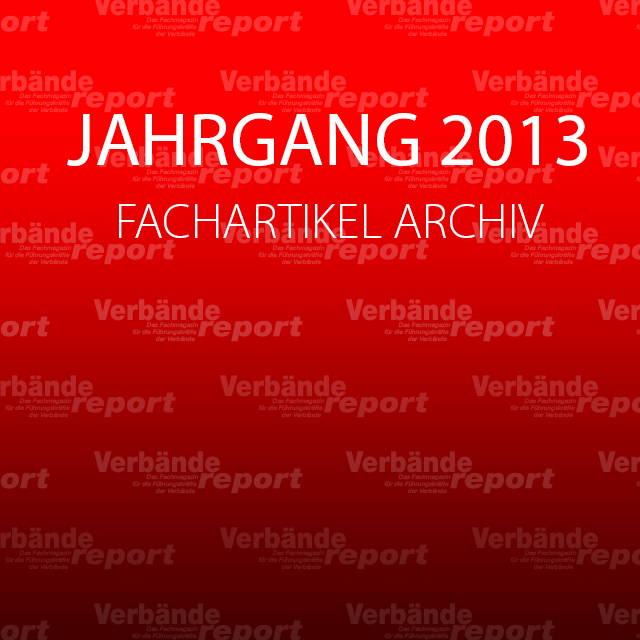Konstruktive Konflikte stärken die Entscheidungsfähigkeit und -qualität eines Vorstandes. Das hat eine Studie in den USA ergeben, die erstmals untersuchte, wie Vorstände gute strategische Entscheidungen treffen. Das Ergebnis überrascht ein wenig: Ein guter inhaltlich getragener – und auch offener – Konflikt zwischen Mitgliedern des Vorstandes befruchtet die Entscheidungsfindung. Zudem verbessert er die langfristige strategische Entscheidung. Die Autoren der Studie haben herausgefunden, dass ein Vorstand, der seine Zeit in Sitzungen zu 10 Prozent mit Berichten sowie operativen Entscheidungen und nur weitere 10 Prozent mit geschäftsordnenden Details verbringt, mit den verbleibenden 80 Prozent sehr gute strategische und langfristige Entscheidungen trifft.

Balanced Conflict, Better Decisions
High-quality, strategic decisions on an association board don’t happen the same way they do in for-profit organizations. A first-of-its-kind study shows that association boards that succeed in strategic decision making face personal conflict head-on, rather than discouraging it.
By Mark T. Engle, FASAE, CAE
Association boards bring together professionals in our communities to make decisions that often touch people’s lives in meaningful ways and can even transform society. Why, then, do we often fail to make consequential or courageous decisions, those game changers that can propel our professions forward? Why is it that, unlike our corporate counterparts with their hierarchal structures and clear decision makers, association boards are often reluctant to make bold decisions? Does reaching consensus actually water down our decisions?
With Paul Salipante, Ph.D., a nonprofit scholar at Case Western Reserve University’s Weatherhead School of Management, I conducted a three-year research project aimed at helping association boards and CEOs to make high-quality, consequential decisions. We wanted to determine how association boards, a group of professional peers with relatively limited time to devote to high-level decision making, actually make weighty strategic decisions such as changing their association’s governance or dues structure or launching a major initiative.
For answers, we conducted a qualitative study that looked at “high-performing” associations as defined in ASAE’s 2006 study 7 Measures of Success and how their boards made wise decisions. A subsequent quantitative study measured how 215 associations and their boards make strategic decisions. A key finding countered what we expected to learn about conflict in decision making among association boards, and it compelled us to dig deeper into the role of debate and conflict in making high-quality, consequential decisions.
In general, we found that high-functioning boards allot time for strategic decision making by clearing their meeting agendas of operational issues and by tasking committees with fact finding and reaching consensus on important issues. Once armed with a committee’s recommendation, the board is then free to discuss high-level strategy. With associations, this may involve debating “the facts of the case” or, frequently with volunteer leaders, deliberating issues of keen personal and professional importance to them.
Simply put, what separates high-functioning boards from other boards is their ability to zero in on strategic rather than operational issues and to balance both positive and negative types of conflict.
Smart Time Management
On average, nonprofit board members spend only 40 hours per year on board activity, which provides limited time to devote to strategic issues that confront associations. To use that time productively, association boards need to use processes that promote fair, thoughtful interaction among board members and a clear understanding of issues.
Our research indicated a significant positive effect on decision quality when the board allocated time to strategic issues – those of high magnitude, relative uncertainty, or significant political ramifications – and conducted a fair and impartial process. Boards should devote fully 75 percent to 80 percent of their meeting time and energy to strategic issues, such as industry trends or weighty issues that hit at the core of the association or profession. Operational tasks, such as approving minutes or task forces, should be conducted before meetings, preferably electronically, to help free up face-to-face time. Spending time on inconsequential issues impedes the progress of associations by robbing the board of valuable time to focus on strategic issues. (See “Use a Board’s Time Wisely” below.)
Rethinking Conflict
Although conflict has long been studied and linked to high-quality decision making in the corporate world, until now little has been published on the role of conflict in the decision-making process of association boards. This is particularly important for associations, where a consensus approach among peers is highly valued in decision making.
Our research indicated that some high-performing boards limit conflict during board meetings by offloading tensions stemming from strategic issues to smaller groups, such as task forces, which debate and work toward consensus on recommendations to be presented to the board. High-quality decisions result from identifying and managing cognitive conflict, which involves contradictory perspectives and their application to the issue, early in the decision-making process. Affective conflict, or personalized conflict that may reflect emotional and political factors, is then identified and managed during the later stages of board decision making, sometimes at the board level. This approach, however, differs from what is often found in the for-profit environment.
In the corporate arena, numerous studies have found that cognitive conflict produces high-quality decisions and is actively embraced at the groupdecision level. In 2007, researchers S. Parayitam, Ph.D., and Robert S. Dooley, Ph.D., studied cognitive and affective conflict and found that both types have important and differing impacts on decision quality. They and other researchers have found that by properly injecting reliable data or research into the decision process at the right time, groups can influence decision quality, whereas debating personal issues impedes decision making.
Our research took what is known on conflict in decision making in the corporate community and applied it to association decision making. Most association board leaders have at one time served on a dysfunctional board that is overwhelmed by affective conflict or operational tasks – or worse, both. Indeed, our study found that high-performing boards handle such challenges skillfully by delegating contentious issues to task forces and often by hiring third-party consultants to enhance their information gathering.
Interestingly, we also found that, if managed well, affective or personal conflict actually improves decisionmaking quality by helping members work through contentious issues before their recommendation is considered for final approval. This came as a surprise to us. We expected to find that encouraging cognitive conflict and discouraging affective conflict would improve decision quality among association boards, similar to the corporate setting. However, our findings supported the opposite, indicating that debating the Associations Now/The Volunteer Leadership Issue January 2012 29 objective merits of the issue (cognitive conflict) during board meetings leads to lower-quality decision making. But allowing personal elements into deliberations (affective conflict) at the board level drives consensus among peers and improves decision quality when members have a personal interest and perceive a fair process in making a decision.
This comes as little surprise, however, to at least one seasoned association executive. “People in associations are much more vested personally [than in the corporate community],” says Thomas Dolan, Ph.D., FACHE, CAE, president and CEO of the American College of Healthcare Executives (ACHE). “In the business world, you are typically a customer, an employee, or a stockholder, whereas in the association world you are an owner, a customer, and sometimes the workforce. Often members are much more vested in what their associations do, and that can get personal.”
Steve Smith, CAE, executive director and CEO of the American Academy of Hospice and Palliative Medicine, also says he sees this dynamic in action. “Fairness and due diligence are critical within committee or board processes,” says Smith. “If a process is seen as unfair, such as when all views are not heard, the focus is likely to be on personal issues or affective conflict.” Smith encourages committee and board members to voice different perspectives on issues and recommends framing statements with “I think,” “I feel,” or “I know” when discussing complex or contentious issues.
Here are two telling case studies on how high-performing associations effectively managed conflict that led to courageous decisions.
A Wholesale Governance Restructuring
Seven years ago, the American Speech-Language-Hearing Association (ASHA) desired to reevaluate and restructure its governance structure, which was similar to a House of Representatives model and included a 150-member Legislative Council, an Executive Board, and several dozen programmatic committees and boards. While there was growing concern at times among volunteer leaders over what they saw as a cumbersome system, it provided a rich legacy of achievement for the association.
An ad hoc committee was formed in 2005 “to conduct its work with consideration of governance trends and issues and best practices of individual membership organizations,” says ASHA Executive Director Arlene A. Pietranton, Ph.D., CAE. A governance consultant was hired, who held educational sessions, encouraged nimbleness and engagement among members, and discussed governance models of other individual-membership professional organizations.
We took volunteer leaders on a journey with us,” Pietranton says. “We surveyed current and recent past members of the Legislative Council and the Executive Board about their experience and what they thought worked well and what didn’t work well. We asked drill-down questions related to fiduciary duties and other governance activities, such as how frequently they either were contacted by or reached out to members,” she says. “The data indicated that, by and large, Executive Board members found it a satisfying and engaging experience, whereas many Legislative Council members were very frustrated. They didn’t feel that their time was well spent and their efforts productive.”
The committee sought out representatives from both groups to participate and effectively managed affective conflict by involving people who, rather than being polarized on issues, were considered independent thinkers open to new ideas. “There was a lot of consideration given to the affective piece,” Pietranton says. “We considered who would be best suited to engage in what we anticipated to be some challenging conversations.”
By 2007, the committee presented an entirely new model of governance to both Legislative Council and Executive Board members, who were strongly encouraged to voice their concerns, questions, and suggestions. The draft new model also was posted on the ASHA website for feedback from the entire membership.
From a conflict perspective, ASHA leaders managed both cognitive and affective conflict effectively. They managed cognitive conflict by focusing on the issue. The leadership approved the purpose statement for the ad hoc committee, retained a governance expert to educate members and help prepare options to consider, and ensured that data was collected and analyzed.
Managing affective conflict entailed focusing on key members and the personal side of debate. The ad hoc committee consisted of a balanced representation of members, and broad input was sought repeatedly from
various constituent groups. Key influencers were identified and sought out for personal input. Finally, options were refined based on member input, and task force members reached out to key influencers in advance of the final vote. (See “Steps to a Fair and Transparent Process” below.)
The result: Members of the Legislative Council approved the change with an overwhelming (85 percent) margin of support.
Remaking a Credentialing Program
In 2005, the Board of Governors of ACHE, an international professional society of more than 35,000 healthcare executives, understood that its longstanding three-tiered credentialing program of Members, Diplomates (CHE), and Fellows (FACHE) needed to change to meet the needs of the increasingly diverse pool of people entering healthcare management. The board knew that affiliates still needed a credentialing program and continuing education, but the reality was that fewer of them were actually becoming credentialed.
To assess the program, the board hired a market research firm for a preliminary audit, which included interviewing and surveying Members, Diplomates, Fellows, representatives from executive search firms, and nonmember CEOs. The results showed that members were unclear on the specific purpose and value of the credentials and that a change was needed to keep the program relevant.
The board decided to combine the existing program to one credential, the FACHE, and eliminate the Diplomate status, among other changes. Feedback from a survey emailed to affiliates showed that Diplomates generally favored the change but that Fellows did not, saying that their Fellow status showed a commitment to the field and to management competency. Eventually, the board authorized the development of a separate process to recognize service, leadership, and giving back to the profession.
Once implemented, the changes garnered relatively little negative reaction. New-member recruitment jumped 16.5 percent in the year following the change, most Diplomates converted to Fellow, and interest in pursuing the Fellow credential rose among both current and former ACHE members.
ACHE’s Dolan attributes the board’s success to establishing an environment of trust and openness at all levels of the organization, from committees that worked to find consensus on recommendations for the board to the board itself. “Boards should create an environment in the boardroom where there is trust and people feel comfortable expressing their feelings, even when they are in conflict with other members,” he says.
If exchanges on issues are not based on data, Dolan stresses that members should clarify when they are expressing opinions. He also recommends capturing input from a variety of stakeholders. “When we initially decided to address this issue, we brought in an outside consultant, an impartial expert,” he says. “We conducted focus groups and surveys and interviewed various stakeholders, from elected leaders to rankand- file affiliates. The data was brought to a task force, which processed and discussed it and made recommendations.”
Fair Processes, Courageous Decisions
Both of these high-performing organizations followed fair and transparent processes that resulted in courageous decisions. In both cases, respected leaders (volunteer and staff) prepared a concept paper that clearly outlined the problem, and they stated goals that included examining association governance trends.
Understanding both affective and cognitive conflict can help nonprofit leaders assess how they function in a board setting. The assumption that affective conflict is bad and cognitive conflict is good may obscure some of the more complex issues at play in association decision making.
Unlike the for-profit world, it appears that both cognitive and affective conflict enhance association boards’ ability to make courageous decisions, as long as the conflict is well understood and adeptly managed by committee or board leaders. Indeed, well-managed affective conflict at even the highest board level can strengthen rather than diminish an association’s resolve to make courageous and consequential decisions.



